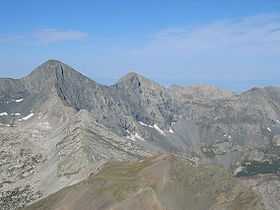Blanca Peak
| Blanca Peak | |
|---|---|
| Sisnaajiní (Navajo) | |
 View of Blanca Peak (left of center) from Mt. Lindsey | |
| Elevation | 14,345 ft (4,372 m) NGVD 29[1] |
| Prominence | 5,325 ft (1,623 m)[2] |
| Listing |
Ultra Colorado Fourteener |
| Location | |
 Blanca Peak | |
| Location | Alamosa, Costilla, Huerfano counties, Colorado, U.S. |
| Range | Sangre de Cristo Range |
| Coordinates | 37°34′38″N 105°29′09″W / 37.57722°N 105.48583°WCoordinates: 37°34′38″N 105°29′09″W / 37.57722°N 105.48583°W[3] |
| Topo map | USGS Blanca Peak |
| Climbing | |
| First ascent | August 14, 1874 by the Wheeler Survey (first recorded) |
| Easiest route | Northwest Face/North Ridge: Scramble (Class 2/easy Class 3) |
Blanca Peak is the highest peak of the Sierra Blanca Massif at the southern tip of the Sangre de Cristo Range in the U.S. State of Colorado. It is the fourth highest peak of the Rocky Mountains, and the eighth highest peak in the contiguous United States.
Geography
It is located at the southern end of the Sangre de Cristo Range, a subrange of the larger Sangre de Cristo Mountains, and is the highest peak in both ranges. It marks the common boundary of Huerfano, Costilla and Alamosa counties, approximately 20 miles (32 km) east-northeast of the town of Alamosa. Approximately 15 miles (24 km) to the north-northwest is Great Sand Dunes National Park and Preserve.
Blanca Peak is notable not only for its absolute height, but also for its great local relief and dominant position at the end of the range, rising high above the San Luis Valley to the west. For example, it rises nearly 7,000 feet (2,100 m) over the edge of the San Luis Valley in only 6 miles (9.7 km).[4] Blanca is also the third most topographically prominent peak in Colorado; it is separated from the higher peaks in the Sawatch Range by relatively low Medano Pass at 9,982 feet (3,043 m).
Blanca Peak heads up three major creeks. Holbrook Creek is on the west, flowing from a basin including Crater Lake, Blue Lakes, and Como Lake. An extremely challenging four wheel drive road accesses Como Lake 11,750 feet (3,580 m), and provides the most common access to Blanca Peak. Most vehicles stop at an elevation of between 8,000 feet (2,400 m) and 10,000 feet (3,000 m) on this road. The Como Lake Road is a designated Alamosa County Road and runs to the edge of the Sangre de Cristo Wilderness just short of Blue Lakes. The Como Lake Road is rated as the most challenging 4WD road in Colorado. The Huerfano River flows from the north side of Blanca Peak. A road, starting out as a two wheel drive road, then becoming a four wheel drive road (less challenging than the Como Lake Road), provides access to the technical climbing on the North Face of Blanca Peak. Blanca Creek drains Blanca Basin under the south slopes of the peak, and Little Ute Creek descends from the Winchell Lakes on the southeast side. However these are not used to access the peak due to private property.
Three other fourteeners are nearby: Mount Lindsey to the east, Ellingwood Point to the north and Little Bear Peak to the southwest. Ellingwood Point is connected to Blanca by a short, high ridge, and is often climbed in conjunction with Blanca. Little Bear also has a high connecting ridge to Blanca, but it is a technical traverse, only recommended for highly experienced parties.[5]
Geology
The granite that makes up the Blanca massif is pre-Cambrian in age, dated at approximately 1.8 billion years old. The major part of the Wet Mountains to the east and the Front Range to the northeast are also pre-Cambrian, also about 1.8 billion years old. In contrast, the Sangre de Cristo Range to the north and the Culebra Range to the south are Permian rock between 250 and 300 million years old.
History
Blanca Peak is known to the Navajo people as the Sacred Mountain of the East: Sisnaajiní[6] (or Tsisnaasjiní[7]), the Dawn or White Shell Mountain. The mountain is considered to be the eastern boundary of the Dinetah, the traditional Navajo homeland. It is associated with the color white, and is said to be covered in daylight and dawn and fastened to the ground with lightning. It is gendered male.[6]
Summitpost notes that "the first recorded ascent of Blanca by the Wheeler Survey was recorded on August 14, 1874, but to their surprise they found evidence of a stone structure possibly built by Ute Indians or wandering Spaniards."[8]
See also
| Wikimedia Commons has media related to Blanca Peak. |
- Outline of Colorado
- Index of Colorado-related articles
- Geology of the Rocky Mountains
- Mountain ranges of the world
- Rocky Mountains
- Southern Rocky Mountains
- Mountain ranges of Colorado
- Sangre de Cristo Mountains
- Sierra Blanca Massif
- Sangre de Cristo Mountains
- Rocky Mountains
- List of Ultras of North America
- Mountain peaks of North America
- Mountain peaks of the Rocky Mountains
- Mountain peaks of the United States
- Mountain peaks of Colorado
- List of Colorado fourteeners
- Major 4000 meter peaks of Colorado
- Mountain peaks of Colorado
References
- ↑ "Blanca Peak, Colorado". Peakbagger.com. Retrieved 2011-02-23.
- ↑ Colorado peaks on peaklist.org
- ↑ "Blanca Peak". Geographic Names Information System, U.S. Geological Survey. Retrieved 2011-02-23.
- ↑ Blanca Peak on TopoQuest
- ↑ Louis W. Dawson II, Dawson's Guide to Colorado's Fourteeners, Volume 2, Blue Clover Press, 1996, ISBN 0-9628867-2-6
- ↑ 6.0 6.1 Robert S. McPherson, Sacred Land, Sacred View: Navajo perceptions of the Four Corners Region, Brigham Young University, ISBN 1-56085-008-6.
- ↑ Lapahie.com
- ↑ "Blanca Peak on Summitpost". SummitPost.org. http://www.summitpost.org/page/150450. Retrieved 2011-05-07.